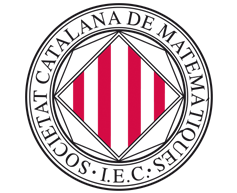Organisers: Marcel Guàrdia (UPC) and Michela Procesi (Roma 3)
Friday Oct 23, 10:30 – 12:40, Zoom room Prat de la Riba 2
10:30 – 11:10 – Dario Bambusi (Università degli studi di Milano)
We study Schrödinger operators with Floquet boundary conditions on flat tori: we use a normal form approach to prove that it can be conjugated to a smoothing perturbation of a block diagonal operator. We deduce two applications: (1) we prove a spectral result giving an asymptotic expansion of all the eigenvalues of the original operator. The expansion is in λ^-δ with δ∈(0,1) for most of the eigenvalues λ (stable eigenvalues), while it is a “directional expansion” for the remaining eigenvalues (unstable eigenvalues). (2) for the case of a time dependent potential we prove a ⟨ t⟩^ϵ estimate for the growth of Sobolev norms. The structure theorem is an improvement of a result proved by Parnovski, Sobolev and Shterenberg, the version that I will present is a quantization of the proof of Nekhoroshev’s theorem (both analytic and geometric parts). This is a joint work with Beatrice Langella and Riccardo Montalto.
11:15 – 11:55 – Filippo Giuliani (Universitat Politècnica de Catalunya)
In this talk I will present some recent results concerning the existence of solutions of some nonlinear Hamiltonian PDEs on tori which exhibit exchanges of energy among Fourier modes in a chaotic-like way. We say that a transition of energy is “chaotic-like” if either the choice of activated modes or the time spent in each transfer can be chosen randomly. We consider the resonant Wave and Beam equations and, through a normal form method, we find finite-dimensional resonant models that well approximate the dynamics of these PDEs for certain time. The construction of the special solutions is based on the analysis of the non-integrable dynamics of such resonant models: we prove existence of transversal heteroclinic connections between invariant objects and we construct symbolic dynamics (a Smale horseshoe). This is a joint work with Marcel Guardia, Pau Martin and Stefano Pasquali.
12:00 – 12:40 – Tere M. Seara (Universitat Politècnica de Catalunya)
We describe a recent method to show instability in Hamiltonian systems which works if some explicit and verifiable transversality conditions are satisfied. The hypothesis can be verified by just checking that some Melnikov type integrals have non-degenerate zeros. This holds for Baire generic sets of perturbations in the C^r topology. The method uses these hypotheses to conclude the existence of orbits, in near integrable Hamiltonian Systems, which change the action coordinate by a quantity independent of the size of the perturbation.
Saturday Oct 24, 15:00 – 17:10, Zoom room Prat de la Riba 2
15:00 – 15:40 – Emanuele Haus (Università di Roma 3º)
In this talk I will present some recent results on the Kirchhoff equation with periodic boundary conditions, in collaboration with Pietro Baldi. Computing the first step of quasilinear normal form, we erase from the equation all the cubic terms giving nonzero contribution to the energy estimates; thus we deduce that, for small initial data of size ε in Sobolev class, the time of existence of the solution is at least of order ε^-4 (which improves the lower bound ε^-2 coming from the linear theory). In the second step of normal form, there remain some resonant terms (which cannot be erased) that give a non-trivial contribution to the energy estimates; this could be interpreted as a sign of non-integrability of the equation. Nonetheless, we show that small initial data satisfying a suitable nonresonance condition produce solutions that exist over a time of order at least ε^-6.
15:45 – 16:25 – Inmaculada Baldomá (Universitat Politècnica de Catalunya)
Consider the restricted planar circular 3-body problem (RPC3BP), namely the planar motion of a massless body under the gravitational influence of two massive bodies, called the primaries, which are assumed to move in a circular motion. By setting a rotating reference system, one has that the primaries are fixed singularities. In addition, the system also possesses the well known Lagrangian-Euler equilibrium points. All of them are in resonance 1:1 in the sense that the primaries and the masless body have the same period. It is well known that the L_3 Lagrangian point is of saddle-center type. We have measured the distance between its one dimensional stable and unstable manifold when the mass ratio, μ, between the masses of the primaries goes to 0. This distance turns out to be exponentially small in μ. This is a joint work with Mar Giralt and Marcel Guardia.
16:30 – 17:10 – Laurent Stolovitch (Université de Nice)
This work, in collabaration with Zhiyan Zhao (Univ. Côte d’Azur, Nice) is concerned with the geometry of germs of real analytic surfaces in (ℂ^2,0) having an isolated Cauchy-Riemann singularity at the origin. We focus on higher-order perturbations of hyperbolic quadrics in the sense of Bishop. Contrary to the elliptic case, it was shown by Moser-Webster that such a surface can be transformed to a normal form by a formal change of coordinates that may not be holomorphic in any neighborhood of the origin. Given a non-degenerate real analytic surface M in (ℂ^2,0) having a hyperbolic CR singularity at the origin, we prove the existence of large amount of distinct holomorphic curves intersecting M along holomorphic hyperbolas. This is a consequence of a non-standard KAM-like theorem for pair of germs of holomorphic involutions {τ_1,τ_2}. We show that such a pair has large amount of invariant analytic sets biholomorphic to {z_1z_2=const} (which is not a torus) in a neighborhood of the origin, and that they are conjugate to restrictions of linear maps on such invariant sets.
